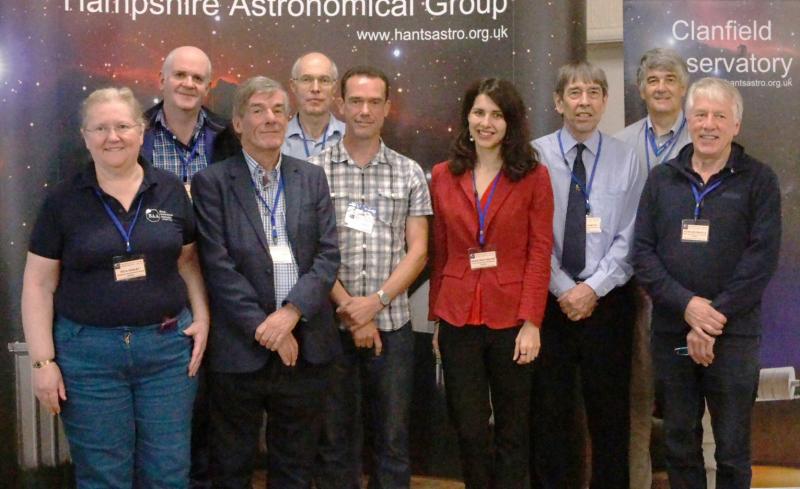Asteroids & Remote Planets Section Meeting, 2019 September 29
2020 August 2
Thanks to the support of the local Hampshire Astronomical Group (HAG), the Section was able to stage a most successful meeting that attracted some 44 participants despite rather wet and windy weather on the day.
In the previous year we founded an Exoplanets Division within the Section, headed up by Roger Dymock, and so the main theme of the day was exoplanets. Six out of nine talks were on this topic and our main speaker, professional astronomer Anastasia Kokori of the Royal Greenwich Observatory who works with Birkbeck University and University College London (UCL), gave a fascinating account of the new ExoClock Project. This project will involve ground-based exoplanet transit observations to support the forthcoming ARIEL (Atmospheric Remote-sensing Infrared Exoplanet Large-survey) space mission, by updating the transit timing ephemerides of up to 1,000 exoplanets. UCL leads this four-year European mission due for launch in mid-2028. It was very timely to hear that these types of observation will be much needed during the coming years. Our exoplanet initiative has started at just the right time for collaborating with professional astronomers involved in ARIEL.
Richard Miles opened proceedings by giving an overview of Section activities, which have seen significant changes. Asteroid discovery is no longer a realistic prospect for the amateur given the number of large telescopes surveying the sky – the current asteroid count (as of 2019 Nov 2) is 839,908; up from 809,045 just prior to the meeting! Richard outlined the niches where amateurs may contribute, including occultation studies, which are especially effective for distant solar system objects; and studying rotation and surface light-scattering properties via photometry, especially main-belt asteroids passing through low phase angles at opposition.

Another niche for the amateur is providing follow-up astrometry of recently discovered near-Earth objects (NEOs) and Peter Birtwhistle gave an up-to-date exposé of recent changes to NEO follow-up. Many more faint NEOs are now posted on the Minor Planet Center NEO Confirmation Page, but the majority are too faint to be reached by amateurs. The new Astrometry Data Exchange Standard (ADES) format requires observations to be submitted using a web form. Peter has written a Windows program to take Astrometrica output and edit it for submission to the MPC. He also highlighted some very effective software made available by Bill Gray (Project Pluto) for achieving accurate camera exposure timing (to ~10ms absolute). It requires short (~0.2s) exposures of global navigation satellites (GNSS), having apparent motion on the sky of 15–30arcsec/s. Astrometry of these images provides a measure of the required timing offset relative to UT.
Roger Dymock opened the afternoon session by exploring the potential for exoplanet activities within the Section, such as transit imaging and analysis, participation in citizen science initiatives (e.g. Planet Hunters and TESS), use of robotic telescopes (e.g. MicroObservatory Robotic Telescope Network), micro-lensing follow-up, astrobiology and the search for extra-terrestrial intelligence. He was particularly enthused by the possibilities for pro-am collaboration with the ARIEL project, for which Section member Mark Salisbury has agreed to be our contact point.
On the exoplanet theme, Peta Bosley gave an introduction to the topic of astrobiology with the Stephen Hawking quote: ‘there is no bigger question in science than the search for extra-terrestrial life’. Peta drew our attention to the importance of understanding the atmospheres of exoplanets, which is the primary goal of ARIEL, and in particular the detection of biosignatures such as infrared reflections of vegetation and various gases. For those wanting to know more, there are now online astrobiology courses offered by a number of organisations in conjunction with universities.
Asteroid occultation studies are increasingly of interest, with exciting times ahead for observers as detailed by our Occultation Coordinator Tim Haymes. Year on year, more observers take up the challenge. Tim described the highlights of 2018–’19, including coverage of the (156) Xanthippe event involving a record total of 19 UK-based observers and 14 timing chords. He maintains a detailed archive of results from UK observers (click here).
Photometric observation of exoplanets transiting in front of their host star is likely to be the mainstay work of the Exoplanet Division. One of the foremost proponents of this activity in the UK is Mark Salisbury, who presented the ‘What, how and why’ of the subject, which is a major growth area for observers across the world. He illustrated the talk with examples of his own transit light curves of WASP-52b and HAT-P-23b, the 0.015mag dip of the latter showing up very clearly when observations from several epochs are combined. Mark explained step-by-step the procedure for optimising observations, including: online planning tools for identifying worthwhile targets, calibration and defocussed imaging using an R filter, and subsequent analysis using the software AstroImageJ. Results can be reported to the Exoplanet Transit Database, the BAA Photometry Database, and NASA’s EXOFAST facility.
Dr Martin Fowler rounded off the day’s talks by showing how he has utilised a robotic telescope network, namely the MicroObservatory Network: a group of weatherproof 0.15m aperture remote-controlled telescopes developed and operated by the Harvard-Smithsonian Center for Astrophysics and supported by NASA, to measure exoplanet transit lightcurves. Martin showed that transit timings with routine accuracies of ~2min (s.d.) are achievable with these relatively small-size telescopes. He also outlined a new NASA initiative called the Exoplanet Transit Survey, that is due to go live in 2020.
We have much to look forward to in coming years in studying the nature of asteroids and remote planets, especially exoplanets in orbit around other stars. Richard Miles closed proceedings with a short Q&A session and by thanking all those (especially members of HAG) who organised the meeting at the Clanfield Memorial Hall, as well as Ann Davies and David Boyd for bringing along the BAA Sales stand.
https://britastro.org/wp-content/uploads/2020/08/fig3_2.JPG
https://britastro.org/wp-content/uploads/2020/08/fig4_1.JPG
https://britastro.org/wp-content/uploads/2020/08/Attendees_halfsize-2.JPG
https://britastro.org/wp-content/uploads/2020/08/Attendees_halfsize-2.JPG
https://britastro.org/wp-content/uploads/2020/08/fig3_2.JPG
| The British Astronomical Association supports amateur astronomers around the UK and the rest of the world. Find out more about the BAA or join us. |
